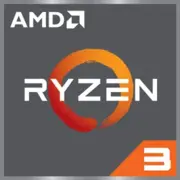AMD Ryzen 3 3250C

AMD Ryzen 3 3250C: A budget processor for everyday tasks in 2025
Analysis of capabilities, use cases, and competitiveness
Architecture and manufacturing process: what's inside the "heart" of a budget laptop?
The AMD Ryzen 3 3250C processor, introduced in 2020, maintains its position in the affordable laptop segment by 2025. It is manufactured using a 14nm process technology (Zen architecture), which falls behind modern 5nm and 7nm chips, but explains the low cost of devices built on it.
- Cores and threads: 2 physical cores and 4 threads thanks to SMT (Simultaneous Multithreading) technology. Base frequency is 2.6 GHz, with a maximum turbo frequency of 3.5 GHz.
- Cache: 4 MB of L3 cache — the minimum capacity for handling uncomplicated tasks.
- Integrated graphics: AMD Radeon Graphics with 3 computing units (192 shader processors) operating at frequencies of up to 1200 MHz. It supports 4K output and VP9/H.265 video decoding, but is not designed for modern gaming.
Architecture features:
- The outdated 14nm process leads to higher energy consumption and heat generation compared to modern chips (e.g., Intel’s 10nm or Apple’s 5nm).
- Support for DDR4-2400 MHz memory limits data processing speed.
Power consumption and TDP: balancing performance and battery life
The processor's TDP (Thermal Design Power) is 15W, typical for ultrabooks and compact laptops.
- Heating: In devices with passive cooling (e.g., thin Chromebooks), throttling may occur under prolonged load. In models with a fan, heat management is better.
- Energy efficiency: Due to the 14nm process, the Ryzen 3 3250C lags behind modern AMD chips (7000 series on 5nm) and Intel Core Ultra (7nm) in efficiency, but for basic tasks, it is sufficient.
Performance: what can 2 cores accomplish in 2025?
Geekbench 6 scores (Single-Core: 762; Multi-Core: 1338) indicate that the processor is suitable for light tasks but not for multi-threaded workloads.
Real-world scenarios:
1. Office work:
- Running a browser (10-15 tabs), Word, Excel, and messengers — no issues.
- Delays are noticeable when using Zoom + Google Docs + several background applications simultaneously.
2. Multimedia:
- Watching 4K video on YouTube: smooth playback due to hardware decoding.
- Photo editing in Lightroom: basic edits (cropping, color correction) — yes, but processing HDR or using neural filters — no.
3. Gaming:
- CS:GO at low settings (720p) — 25-35 FPS.
- Minecraft (without shaders) — 40-50 FPS.
- Modern AAA titles (Cyberpunk 2077, Starfield) — will not run.
Turbo mode:
Under short-term load (e.g., opening a "heavy" PDF), frequency can boost to 3.5 GHz, but during extended use (video rendering), it drops back to base frequency due to overheating.
Use cases: who is suited for the Ryzen 3 3250C?
1. Students: For studies (typing, presentations, online courses).
2. Office workers: Document handling and corporate services.
3. Home users: Web browsing, streaming, social media communication.
4. Elderly individuals: Ease of use, low price.
Not suitable for:
- Gamers (except retro games).
- Designers, video engineers, programmers using heavy IDEs.
Battery life: how long will the laptop last?
In devices with a 40-50 Wh battery, usage time reaches 6-8 hours under moderate use (brightness at 50%, Wi-Fi, office tasks).
Power-saving technologies:
- AMD SenseMI: Dynamic control of frequency and voltage.
- "Battery Saver" mode in Windows/Linux: reduces performance to extend battery life.
Recommendation: Choose laptops with IPS screens (low power consumption) and SSDs (less load on CPU).
Comparison with competitors: who is better in 2025?
1. AMD Ryzen 3 7320U (4 cores/8 threads, 6nm, Zen 2): 30-40% faster in multi-threaded tasks, laptops starting from $450.
2. Intel Core i3-1215U (6nm, 2 cores/4 threads): Comparable single-threaded performance, but Intel Xe graphics are 15-20% faster.
3. Apple M1 (5nm, 4 cores/4 threads): 2-3 times higher performance, but runs macOS with a starting price of $800.
Conclusion: The Ryzen 3 3250C is relevant only in the budget segment (laptops priced up to $400).
Pros and cons: is it worth buying?
Strengths:
- Low device prices ($300-$450).
- Sufficient performance for everyday tasks.
- Support for modern codecs for multimedia.
Weaknesses:
- Only 2 cores — multitasking is limited.
- Outdated 14nm fabrication process.
- Poor upgrade potential: CPU replacement in laptops is not possible.
Recommendations for choosing a laptop
1. Type of device:
- Ultrabook: ASUS VivoBook 15, Lenovo IdeaPad 3 — weighs up to 1.5 kg, with a 14-15.6" screen.
- Chromebook: HP Chromebook 14 — for web browsing.
2. What to pay attention to:
- RAM: At least 8 GB (preferably 16 GB for "just in case").
- Storage: SSD only (256 GB and up).
- Screen: Full HD IPS — causes less eye strain.
Examples of 2025 models:
- Acer Aspire 3 (A315-23-R3D5): 8 GB RAM, 512 GB SSD, price $349.
- HP 15-dw2000: 16 GB RAM, 1 TB SSD, price $429.
Final conclusion: who is the Ryzen 3 3250C for?
This processor is a choice for those who are not willing to pay extra for modern technologies but need a reliable laptop for basic tasks.
Key benefits:
- Affordable price.
- Energy efficiency for 6-8 hours of work.
- Support for everyday applications.
Alternatives: If the budget allows, it’s better to choose a laptop with the Ryzen 5 5500U or Intel Core i5-1235U — they will last longer and will not disappoint in multitasking.
Conclusion: The AMD Ryzen 3 3250C in 2025 is a workhorse for those who prioritize saving. But remember: technology is constantly evolving, and even among budget models, there are newer options available.
Basic
CPU Specifications
GPU Specifications
Miscellaneous
Benchmarks
Compared to Other CPU
Share in social media
Or Link To Us
<a href="https://cputronic.com/cpu/amd-ryzen-3-3250c" target="_blank">AMD Ryzen 3 3250C</a>